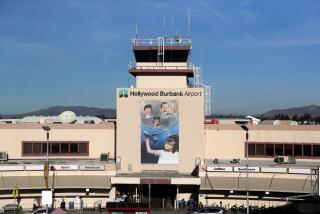Jet Diversion Cited in Call for New Terminal
- Share via
LOS ANGELES — The diversion of a crippled Southwest Airlines jet from Burbank Airport to Ontario International Airport shows the need to improve safety by replacing Burbank’s aging terminal, which is too close to the runways, a top airfield official said Wednesday.
“We are managing risk,” said Carl Raggio, president of the Burbank-Glendale-Pasadena Airport Authority. “The sooner we move our terminal the less risky it will be.”
While emphasizing that flight operations at Burbank Airport meet minimum Federal Aviation Administration safety standards, Raggio and other officials said a new terminal farther from airport runways would be safer.
On Tuesday, Southwest Airlines’ Flight 1767--unable to deploy one of its three main sections of landing gear as it prepared to land at Burbank after a trip from Las Vegas--diverted to Ontario, where it made an emergency landing. No one was injured, but passengers were badly shaken.
Officials said Wednesday that Ontario airport was more appropriate for an emergency landing because it has longer runways than Burbank and the area is less densely developed.
Planes attempting emergency landings often are diverted from various airports to Ontario because of its spacious layout, veteran pilots say. A spokeswoman for Southwest Airlines said the pilot’s decision to head for Ontario did not involve the proximity of the Burbank terminal to its runways.
The panel that controls Burbank Airport has split sharply over proposals to build a larger terminal farther from the runways that could better handle the more than 5 million passengers who use the airport annually.
Representatives of Burbank and Los Angeles have criticized and challenged airport proposals approved last month by the FAA, claiming that increased noise and congestion would be intolerable.
The Burbank terminal is 313 feet from the center line of the nearest runway. Under FAA standards, any new terminals must be at least 750 feet away from the center line.
A National Transportation Safety Board investigator said Wednesday that the problem with the landing gear of Flight 1767 apparently involved a strut that helps support the weight of the plane on the ground. The mechanism was overextended in the wheel well and failed to respond properly when the flight crew activated it for landing, he said.
“They were only able to get it out partially,” said George Petterson, the NTSB air safety investigator handling the incident. “They knew that they were going to land without that landing gear.”
Petterson said a complete investigation would take about six months.
Officials said the jetliner, which suffered minor damage during the emergency landing, would be repaired and returned to service.
Authorities said a maintenance history of the 8-year-old aircraft showed no unusual problems. The aircraft’s last major maintenance check, which did not include overhauling the landing gear, was conducted April 16, they said.
The aircraft, which was carrying 127 passengers and a crew of five on the flight from Las Vegas to Burbank, was not being overworked, authorities said.
“You can keep that bird in the sky 24 hours a day, 7 days a week, 365 days a year,” said Tim Pile, a spokesman for the FAA, which is assisting the NTSB investigation.
More to Read
Sign up for Essential California
The most important California stories and recommendations in your inbox every morning.
You may occasionally receive promotional content from the Los Angeles Times.













